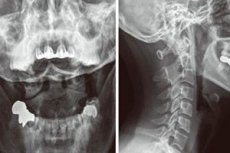Medical expert of the article
New publications
Rotational subluxations of the atlas
Last reviewed: 04.07.2025

All iLive content is medically reviewed or fact checked to ensure as much factual accuracy as possible.
We have strict sourcing guidelines and only link to reputable media sites, academic research institutions and, whenever possible, medically peer reviewed studies. Note that the numbers in parentheses ([1], [2], etc.) are clickable links to these studies.
If you feel that any of our content is inaccurate, out-of-date, or otherwise questionable, please select it and press Ctrl + Enter.

Rotational subluxations of the atlas occur as a result of direct or indirect force or active uncoordinated contraction of the neck muscles.
Atlantoaxial subluxation causes decreased neck rotation and is characterized by excessive movement between the first (C1) and second (C2) cervical vertebrae due to either a bony or ligamentous disorder.
Epidemiology
According to M. N. Nikitin (1966), they constituted 31.5% of all cervical spine injuries and 8.8% of all spinal injuries. Such a high percentage of traumatic rotational subluxations of the atlas apparently depends on the special selection of these victims - 78 victims of this type were observed over 11 years.
 [ 3 ]
[ 3 ]
Causes rotatory subluxation of the atlas
Rotational subluxations of the atlas can occur as a result of exposure to gross mechanical force (hitting the head on the bottom of a river while diving) or minor mechanical violence (a sharp backward turn of the head).
 [ 4 ]
[ 4 ]
Risk factors
Congenital:
- Down syndrome (20%).
- Morquio syndrome.
- Spondyloepiphyseal dysplasia.
- Osteogenesis imperfecta.
- Marfan disease.
- Neurofibromatosis type 1 (NF1).
Arthritis:
- Rheumatoid arthritis.
- Psoriatic arthritis.
- Reiter's syndrome (reactive arthritis).
- Ankylosing spondylitis.
- Systemic lupus erythematosus (SLE).
Acquired:
- Injuries.
- Retropharyngeal abscess/Grisel syndrome.
Symptoms rotatory subluxation of the atlas
Symptoms of rotational subluxations of the atlas are quite typical and consist of the following main symptoms: forced motionless vicious position of the head with its tilt and rotation to the "healthy" side; pain in the upper, cervical region; tension of the neck muscles on the "sick" side, i.e. on the side of the subluxation of the lateral mass of the atlas; limitation of rotation of the head to the "sick" side. Radiologically, an asymmetrical position of the atlas in relation to the axis is determined due to the tilt and horizontal shift of the atlas to the "healthy" side.
 [ 7 ]
[ 7 ]
Treatment rotatory subluxation of the atlas
Treatment of rotational subluxations of the atlas consists of reduction of the subluxation and subsequent immobilization. Reduction can be performed by traction with a Glisson loop or by one-stage reduction.
The choice of reduction method depends on the qualifications of the doctor and the presence or absence of concomitant injuries. One-stage reduction is indicated for uncomplicated rotational subluxations.
After the reduction is achieved, immobilization is performed either with a craniothoracic plaster cast or a Shantz collar with a large occipital visor for 4-6 weeks. In some cases, a cotton-gauze Shantz collar can be used. In complicated cases, after the reduction is achieved, immobilization is performed for longer periods, depending on the nature of additional concomitant injuries.

